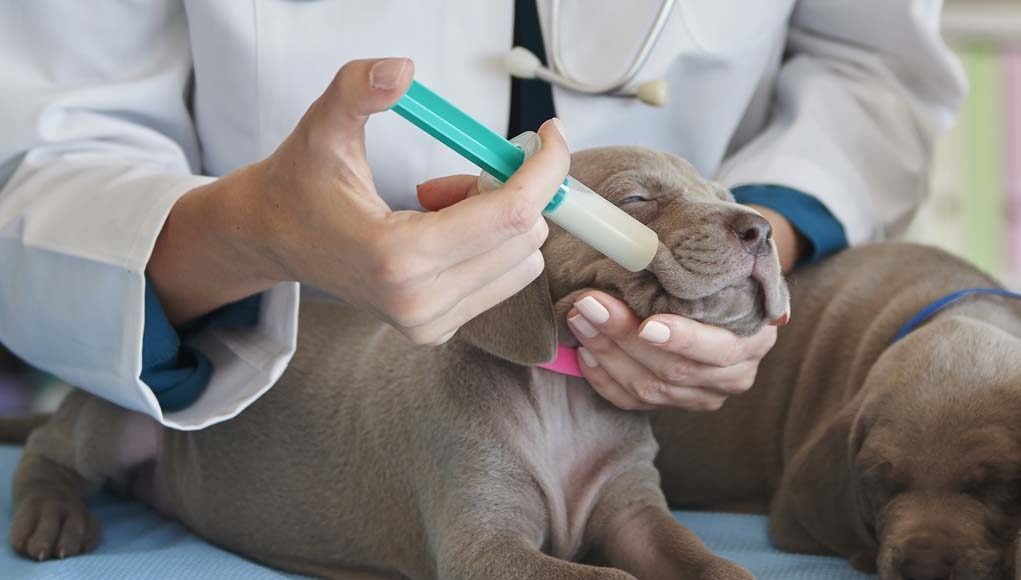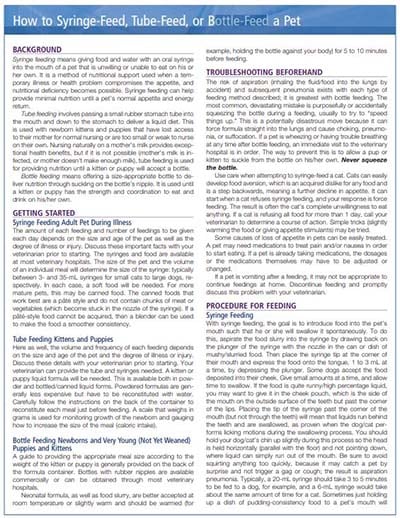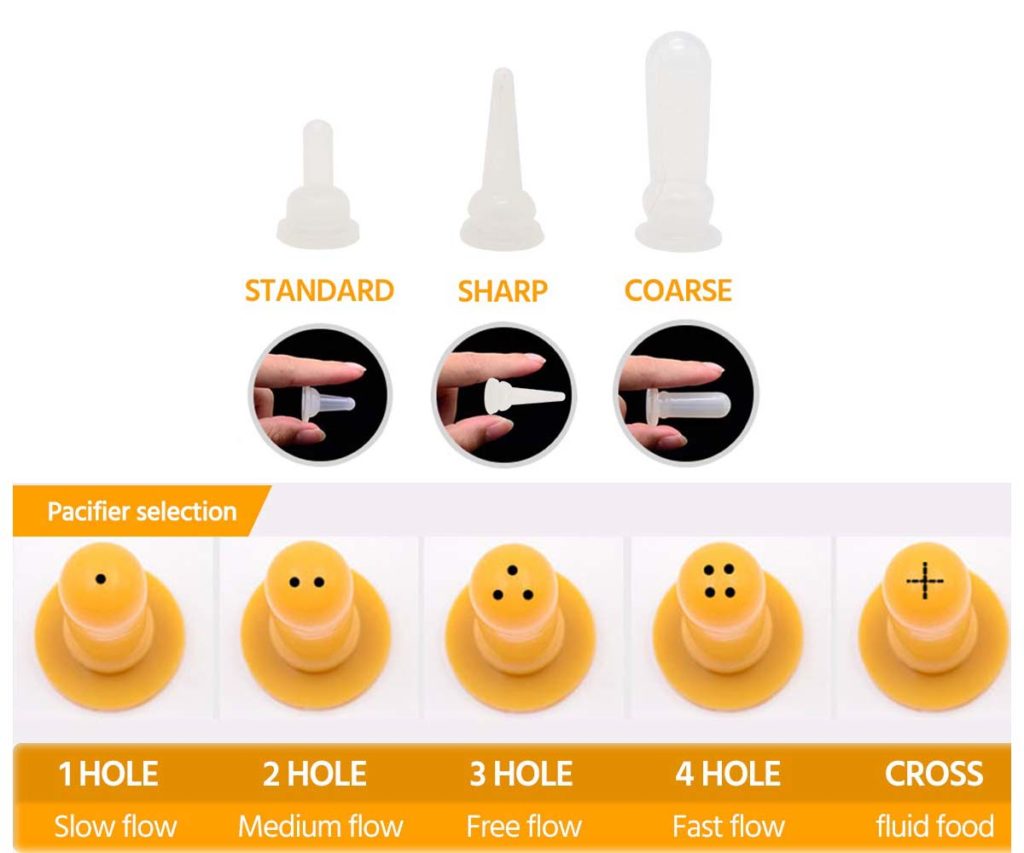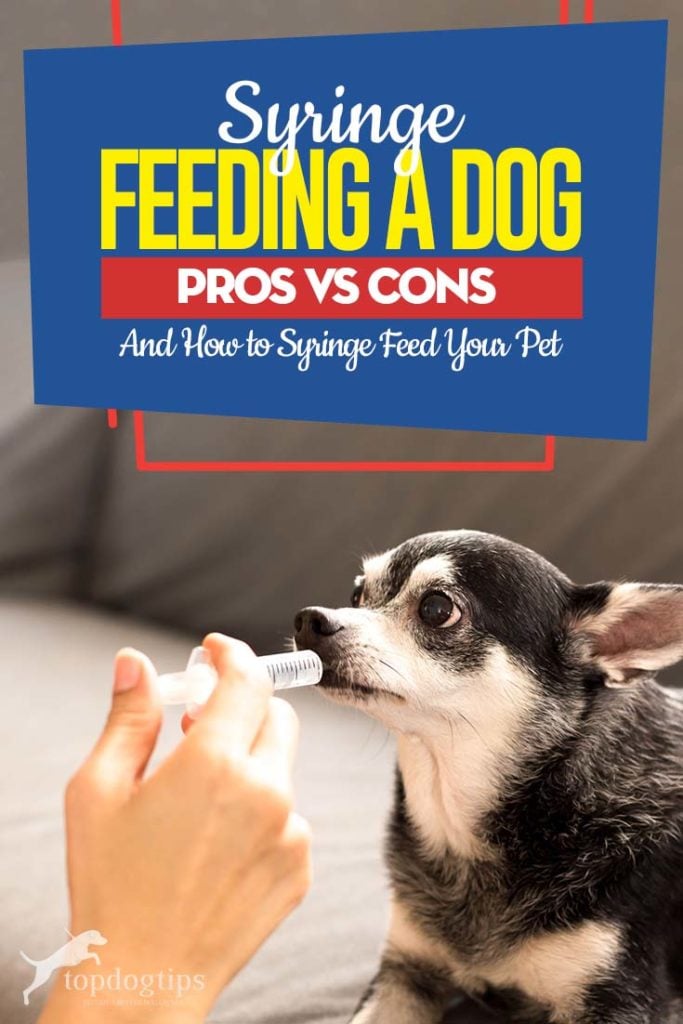Table of Contents
Syringe feeding a dog may be necessary when your pet has serious dental health problems, a broken jaw, is recuperating from surgery and are too weak to eat on their own, or when you found an abandoned puppy under the age of four weeks old, which is too young for them to consume solid food.
They may also become anorexic or hyporexic for a variety of other reasons. The syringe is also used for administering liquid medication.

The Liquid Syringe Diet for Dogs
This approach to feeding a dog has its own benefits and disadvantages.
The good thing is that you'll be able to give your pet some nutrition, and some calories (even if not the full amount; a little is better than nothing, after all).
Syringe feeding is also cheap and relatively easy to do, as long as your pup cooperates.
In terms of the disadvantages and dangers of syringe feeding a dog, there are a few of those as well. It's unlikely you'll provide all the necessary nutrients using this method.
Also, your pet may not allow you to feed them this way, and forcing feeding a dog with a syringe is not recommended.
The bottom line is that a liquid diet and syringe feeding a dog should be only a temporary solution in order to provide some calories and nutrients to a dog.
This should not be a long-term feeding plan.
Before You Begin Syringe Feeding Your Dog
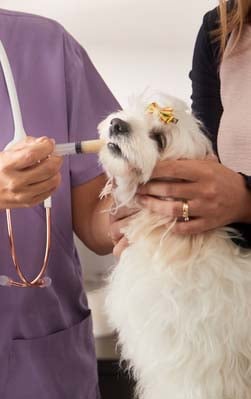
The first thing to make sure when syringe feeding a dog or puppy is that the food you are offering is well-balanced, rich in nutrients and calories the dog needs while at the same time there's not too much of a good thing.
Ask your vet for an appropriate mixture.
The food (or medicine) may already be liquid. If it's solid, it can be made into liquid by using a blender or food processor, with the addition of water, milk, tuna sauce, or other appropriate liquid.
Feed your dog the same amount of food – whether kibble, wet food, or homemade meal – they would normally eat each day (typically, anywhere from 1 to 4 cups, depending on the breed, activity level, health, and the type of food).
The frequency for you to syringe feed a dog or puppy will depend on their age.
Young puppies should be fed every two hours, and sometimes even more frequently.
Adult dogs that normally eat once or twice a day will need to be syringe-fed 2 to 5 times a day.
Note: Syringe feeding will not work for all dogs and many animals will not allow you to feed them this way.
If that's the case, and you've exhausted all other options (finger feeding, bottle feeding, food meatballs, and anything else), your next option is feeding tubes.
Ask your veterinarian if this can be arranged.
6 Steps to Syringe Feeding a Dog
Before you begin to syringe feed a dog, you will need the appropriately sized syringe capable of pushing a thicker liquid through.
Feeding syringes can be purchased through Amazon (like this), Chewy (like this) or obtained from a veterinarian.
You will also need a paper towel or a damp washcloth handy to wipe a dog's mouth and face.
Step #1 – Prepare the liquid diet (or meds) using a blender or food processor. Ensure the correct balance of nutrients and calories.
Microwave until the liquid is of dog's body temperature or thereabout (warm-ish food flows better than cold).
Step #2 – Before using it, wash and rinse the syringe with warm water to clean away any manufacturer's dust. Test to ensure the plunger is working smoothly.
Step #3 – Fill the syringe with liquid food.
Step #4 – With your dog comfortably positioned at eye level, open their mouth. I
f the pet is anxious, you may need to enlist the help of a family member to help open a dog's mouth and keep them steady.
Step #5 – Carefully insert the syringe and slowly empty the contents into a dog’s mouth. Do NOT insert the syringe into the dog’s throat due to risk of choking.
Step #6 – Once the syringe is empty, close your dog’s mouth. If you have to help the dog swallow, lift their head so that the food will flow down the throat.
If your pup can chew, allow them to do so, making sure they also swallow it.
Remember to wash the syringe, bottle, cap and nipple after use.
For more details, here's a PDF document on How to Syringe Feed a Dog, written by veterinarians.
It also includes advice on other methods, such as tube feeding a dog or bottle feeding a dog. Bookmark, or download and print this to keep for future reference.
Some Tips for Syringe Feeding a Dog
Stay calm. All dogs can sense owner's emotions and will share them, so to keep your pet calm, you must be the same.
Feed the dog in a confident, relaxed manner, speaking in soft voice. Be patient and praise to encourage your dog to consume the food.
Use a leash/harness. Fasten a leash (and, if possible, a harness) onto your dog in case they decide to wander off.
This aid gives you better control and the ability to reign your dog in.
Use the teeth gap. To make syringe feeding easier and less uncomfortable, use the natural gap behind the canine's fangs as an insertion point for the syringe.
Go slow. To reduce anxiety in the dog, keep your movement slow and feed gradually. You will also know when you are pushing too much food as it will begin to gather in your dog's cheeks and they will most likely try to push away.
Veterinary aid. If you are having difficulty with the syringe feeding process, or if your dog's condition is not improving, be sure to call your veterinarian for assistance or for additional medical care.
There are other methods they can recommend.
The Best Feeding Syringe for Dogs
There's a number of options of feeding syringe for dogs you can try: some come as a single syringe in a package, while others come in a kit, with different sizes, caps, soft rubber nipples, bottles, cleaning brushes and other helpful tools which make feeding and administering medicine to a dog easier.
Pacifiers are another helpful addition, and you can often get different designs based on the age of your puppy.
Nipples, which are made from soft rubber/silicone material, help to prevent scratching a dog's gums. They can be used on both the syringe and the bottle.
Here are the best feeding syringe for dogs options available over the counter.
- SQUEEZE BOTTLE - 60ml nursing...
- SMALL ANIMAL FEEDER SET - 1ml...
- 5 REPLACEABLE NIPPLES -...
- 5ML BROWN FEEDER - The brown...
- NEWBORN KITTENS & PUPPIES GIFT...
- PERFECT FOR BABY PETS: The...
- QUALITY CONSTRUCTION: Lixit...
- FOOD AND MEDICINE: The syringe...
- Syringe: The 10ML features...
- Syringe features a tip which...
- Excellent for flushing or tube...
- Usually use a number 8-12...
- PERFECT FOR BABY PETS: The...
- QUALITY CONSTRUCTION: Lixit...
- FOOD AND MEDICINE: The syringe...
- THE PERFECT SIZE: The 35ML...
- RECOMMENDED BY VETERINARIANS -...
- ACCURATE FEEDING - Syringe...
- 2 TIP OPTIONS - Nipple tip is...
- DISHWASHER SAFE - Medication...
- IDEAL FOR DOGS, CATS, AND...
Reasons Why a Dog May Stop Eating
If your dog was a healthy eater and has suddenly stopped, the first thing you will want to do is to make sure there isn't an underlying health problem.
There are many reasons why dogs refuse to eat, but a trip to the vet may be required to rule out more serious issues.
Too many treats. If you are training your dog with treats, or are giving in to their mooching, you need to cut back or completely remove treats from the diet.
When it's time for the dog's meal, place the bowl in front of them and allow for 10 minutes to eat it.
If the dog walks away, pick up the food and don't give it back until the next mealtime. Resist the urge to give treats in between feedings.
Change the food. Your dog may be tired of (or never really liked) the food in the first place. Try changing to a new brand or a new flavor profile in the same brand to see if they resume eating, or try a homemade diet.
High quality dog food brands may cost more, but some are also made with better ingredients which makes it more nutritionally dense and more appealing to the dog's sense of smell.
Too many food changes. If you have been changing your pet's food much too often, this can turn them into a picky eater.
When you find a dog food brand your pooch will eat, stick with it for as long as possible. And whenever you need to change their food, do so gradually over a one or two week period.
Lazy dog. Inactive dogs are not burning as many calories as their active counterparts.
If your pet is healthy and able, take them for more (longer) walks or engage them in play or with interactive toys to increase their energy expenditure.
In Summary
If your adult dog or puppy aren't eating and your vet has recommended syringe feeding a dog, then do so with the right set of tools, preparation and knowledge.
It's easy to hurt a dog during this process if you're not careful, especially if they're young and/or very anxious, so go at it slowly.
Get the appropriately sized feeding syringe for dogs (or a whole kit with nipples, pacifiers, bottles and more), prepare the ingredients and ensure they meet the nutritional requirements of the dog, then liquefy the food (or medicine) and warm it up a little.
When ready, follow the above tips on getting the mixture into your pet safely. If your dog doesn't improve, be sure to consult with a veterinarian for a follow-up.
Common Questions about Syringe Feeding Your Dog
If you are worried about force-feeding your dog with a syringe or just using a syringe in general, you may have some questions.
The following should clear up any doubts you have as you feed your dog with this method. Remember that your vet is also a great source of information if you have additional questions.
Is It OK to Syringe Feed a Dog?
Yes, it is okay to force-feed your dog with a syringe, but not as a permanent solution.
There are rare cases where your vet may suggest using a syringe to force-feed your canine in the long term, but this is not common.
It is much more common for this to be a temporary measure. The goal will typically be to switch your dog back to normal dog foods.
Think of using a syringe as a way to ensure your dog gets vital nutrients and calories during health struggles.
How Do You Force Feed a Dog with a Syringe?
You can ask your vet to show you how to force-feed your dog with a syringe if you are unsure. That being said, the process is fairly straightforward.
You need to start by finding a syringe about the size that you need. Remember that you need to be able to force the liquid food through it.
You should also grab a damp washcloth to clean up any spills.
Before you start force-feeding your pup, prepare the food. Liquify it if necessary. You should also microwave it briefly so it is a similar temperature to your dog's body.
You also want to test the syringe with warm water before using it.
When you are ready, put the liquid dog food in the syringe. Put your pup at eye level and open his mouth.
Put the syringe in your dog's mouth and slowly push out the contents. The two important things to remember are NOT to put the syringe in the throat and to push slowly.
You don't want to accidentally choke your dog.
Once the food is in your dog's mouth, gently close it. If he doesn't swallow to eat food, lift his head slightly. Always keep a close eye on your pup during the process as you don't want him to choke.
If you are giving your dog's food to him via syringe, he likely has medical problems. Pay attention to relevant issues as you feed him.
How Much Water Should I Syringe Feed My Dog?
If your dog needs to be syringe-fed, you may also give him water like this. You should aim to give your dog between 5 and 10 milliliters of water for each pound of his body weight.
No matter what he weighs, however, don't syringe feed him more than 100 milliliters at once. You need to give him time for drinking and that isn't possible with too much liquid.
How Do You Force Feed a Dog?
Sometimes you may not know how to get your dog fed, especially if he doesn't have an appetite. You can force-feed him with a syringe if he doesn't seem hungry but hasn't eaten.
Before trying this, you can also work to make the food in his bowl more tempting. Try switching to wet food instead of dry kibble.
Or try adding some dog-safe baby food to his food. You may also want to warm up his food. Or you can give him dog-safe human food, such as rice or chicken.
READ NEXT: How Much to Feed a Puppy and How Often Should Puppies Eat
Disclosure: We may earn affiliate commissions at no cost to you from the links on this page. This did not affect our assessment of products. Read more here and find full disclosure here.


